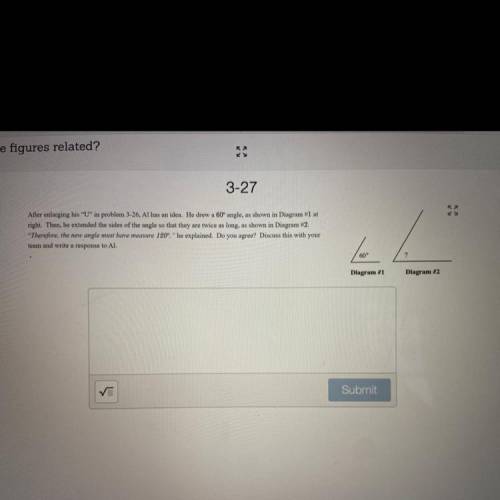
Mathematics, 08.10.2021 14:00 giavanleer14
After enlarging his "U" in problem 3-26, Al has an idea. He drew a 60° angle, as shown in Diagram #1 at
right. Then, he extended the sides of the angle so that they are twice as long, as shown in Diagram #2.
"Therefore, the new angle must have measure 120°," he explained. Do you agree? Discuss this with your
team and write a response to Al.


Answers: 3


Another question on Mathematics

Mathematics, 21.06.2019 18:40
Airplane speeds are measured in three different ways: (1) indicated speed, (2) true speed, and (3) ground speed. the indicated airspeed is the airspeed given by an instrument called an airspeed indicator. a plane’s indicated airspeed is different from its true airspeed because the indicator is affected by temperature changes and different altitudes of air pressure. the true airspeed is the speed of the airplane relative to the wind. ground speed is the speed of the airplane relative to the ground. for example, a plane flying at a true airspeed of 150 knots into a headwind of 25 knots will have a ground speed of 125 knots. the problems below refer to static and dynamic pressure. static pressure is used when a body is in motion or at rest at a constant speed and direction. dynamic pressure is used when a body in motion changes speed or direction or both. a gauge compares these pressures, giving pilots an indicated airspeed. in problem #s 1 and 2, use the following information. the indicated airspeed s (in knots) of an airplane is given by an airspeed indicator that measures the difference p (in inches of mercury) between the static and dynamic pressures. the relationship between s and p can be modeled by s=136.4p√+4.5. 1. find the differential pressure when the indicated airspeed is 157 knots. 2. find the change in the differential pressure of an airplane that was traveling at 218 knots and slowed down to195 knots. in problem #s 3 and 4, use the following information. the true airspeed t (in knots) of an airplane can be modeled by t=(1+a50,000) ⋅ s, where a is the altitude (in feet) and s is the indicated airspeed (in knots). 3. write the equation for true airspeed t in terms of altitude and differential pressure p. 4. a plane is flying with a true airspeed of 280 knots at an altitude of 20,000 feet. estimate the differential pressure. explain why you think your estimate is correct.
Answers: 2

Mathematics, 21.06.2019 19:30
If y varies directly as x2 and y=6 when x=6, find the constant of variation.
Answers: 2

Mathematics, 21.06.2019 20:10
Look at the hyperbola graphed below. the hyperbola gets very close to the red lines on the graph, but it never touches them. which term describes each of the red lines? o o o o a. asymptote b. directrix c. focus d. axis
Answers: 3

Mathematics, 21.06.2019 23:00
Calculate the average rate of change over the interval [1, 3] for the following function. f(x)=4(5)^x a. -260 b. 260 c. 240 d. -240
Answers: 1
You know the right answer?
After enlarging his "U" in problem 3-26, Al has an idea. He drew a 60° angle, as shown in Diagram #1...
Questions


Chemistry, 19.04.2021 17:40


Mathematics, 19.04.2021 17:40

Mathematics, 19.04.2021 17:40

English, 19.04.2021 17:40

Mathematics, 19.04.2021 17:40



Mathematics, 19.04.2021 17:40



Mathematics, 19.04.2021 17:40

Mathematics, 19.04.2021 17:40




SAT, 19.04.2021 17:40


Mathematics, 19.04.2021 17:40



